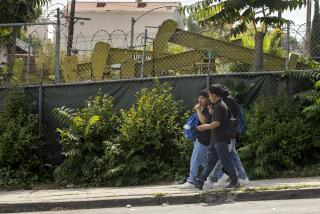Earthquake: The Long Road Back : Spill Impact Worse Than First Feared : Wildlife: Most Santa Clara River creatures that die from oil ingestion or hypothermia may never be found.
- Share via
An oil spill in the Santa Clara River will have a more devastating effect on wildlife in the ecologically sensitive area than biologists will ever be able to document, state Department of Fish and Game officials said Friday.
Meanwhile, department officials raised the estimated amount of oil spilled from 168,000 gallons to 214,000 gallons after new studies showed that more oil was in the ruptured pipeline than officials initially believed.
Although biologists have recovered only 65 oiled birds, reptiles and mammals, most of the creatures that die from the oil by ingestion or hypothermia will never be found, officials said.
Many small birds such as finches, gnatcatchers, vireos and orioles that become contaminated with oil will fly off into the brush to die where their carcasses cannot be found.
Larger animals such as birds of prey that feed on oiled fish or rodents or become tainted with oiled feathers often fly miles from the site before they are overcome with illness. Turtles, toads and lizards crawl under rocks when ill. And poisoned mice scurry off into the brush to die.
“This spill is having a greater effect on wildlife than the numbers (of dead animals) indicate,” said Bob Schlichting, a spokesman for the Department of Fish and Game. “We may never get the numbers of all the affected birds. And even if they don’t die outright, their reproduction may be affected when breeding season begins in February.”
The endangered least Bell’s vireo, for instance, nests within the 12- to 15-mile stretch of the river east of Piru that was contaminated when an oil pipeline ruptured in Valencia during the earthquake.
Although the migratory vireos have not yet arrived from their winter habitat in the south, wildlife biologists fear the spill might harm the birds’ food supplies and reproduction.
“We’re hoping now that we will have the oil cleaned up before they get here in March so there won’t be any direct effects,” Department of Fish and Game Capt. Roger Reese said. “But we are concerned about indirect effects such as contamination of the food chain.”
The vireos feed on invertebrate insects, which could become toxic from oil residue in the soil, Reese said. Also, the oil contamination could reduce the quantity of food available for the birds and harm their populations for many years.
“We just can’t get all the oil,” Reese said. “It’s impossible.” Reese said the department plans a complete natural resources damage assessment to study the effects on fish, birds, invertebrates, reptiles and amphibians.
“We can only find a small percentage of those affected directly by the oil,” he said.
In addition to the wildlife, officials have retrieved 637 dead fish, including three endangered unarmored three-spined sticklebacks that also live and breed in the area.
Of 54 oiled birds found, 27 are dead. The survivors may not live long, said Lloyd Kiff, director of the Western Foundation of Vertebrate Zoology and an expert on birds.
“People rush to the rescue and spend tens of thousands of dollars saving those few individuals,” he said. “But I’m told that almost none of those animals survive. The treatment makes the rescuers feel better than it does the birds.”
Kiff said the oil-tainted stretch of the river has a thick population of wildlife because of its distance from populated areas.
“That’s a very important stretch of river,” Kiff said. “There is still ecological integrity to the riparian habitat there. Just look around Southern California and see how many rivers we have with any habitat left.”
Although the Department of Fish and Game elevated its spill estimate to 214,000 gallons, Atlantic Richfield Co., the parent company of Four-Corners Pipeline, said it estimates the spill at only 172,000 gallons. That is an increase from early company estimates of 147,000 gallons.
Arco spokesman Albert Greenstein estimated that about 64,000 gallons of oil has been retrieved. But he said that does not mean that 150,000 gallons--or 108,000 gallons depending on the estimate--remain in the river.
“A lot has been absorbed into the soil or evaporated,” he said. But Arco will make every effort to see the river is cleaned up as much as possible, he said.
Workers have been cutting off vegetation just above the roots so it will grow back. They have washed some plants and have removed some soil. And the work will continue for weeks.
But the oil has smeared a blackened ring around the willows along the banks, and clumps of oil remain in the watercress and other vegetation in the stream bed. Some isolated pools of the river still showed a heavy sheen. But oil is no longer floating on the moving water.
Kiff and Reese agreed that the short-term loss of fish and wildlife is not as devastating as development.
“It’s not as bad as having it paved over with asphalt,” Kiff said. “But it is very distressing. It happened at a most unfortunate place.”
More to Read
Sign up for Essential California
The most important California stories and recommendations in your inbox every morning.
You may occasionally receive promotional content from the Los Angeles Times.










